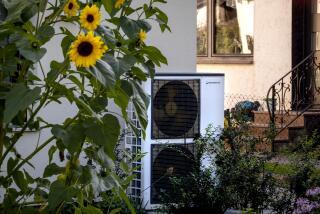Montanans Dig Into the Earth as Heat Bills Soar
- Share via
BILLINGS, Mont. — Because energy rates were rising, Brian McGovern was nervous about his plans to double the size of his print shop. He thought long about the heating bills, which are already hitting $500 a month at his downtown Insty Prints business.
He had to dig deep for a solution. Literally.
When ground is broken in April on his 5,400-square-foot shop, a series of 200-foot deep holes will be drilled to allow the business to get help with heating and cooling from the earth’s crust. He expects his $500 bills to drop to $100 or less.
“It’s going to work pretty slick. The ground can produce the heat for free,” McGovern said. “To me it makes sense. And I did a lot of looking and studying before I did this.”
McGovern is part of a growing trend of businesses, schools and homes turning to ground-source heating and cooling. The only regular cost is running an electric compressor.
Barring major volcanic activity or an extended ice age, ground-source heat is reliable, said Kevin Nelson, owner of Geo Tech, a Billings firm that designs and installs the systems. From about 5 feet below the surface to more than 1,000 feet down, the earth’s crust is a stable temperature throughout the year. In Montana, the temperature ranges between 45 and 55 degrees.
Plastic pipes threaded deep into the earth carry an antifreeze solution. For a residential home, typically four “loops” are needed. The liquid is warmed to the temperature of the surrounding earth. It is then pumped back to the surface where the heat is concentrated with a compressor and sent through the rest of the home.
In summer, the reverse occurs. The system collects heat from a home and injects it back into the earth. Along with the sun, this process helps gently warm the crust for the upcoming winter, Nelson said.
“Anything we’re taking out in the winter is easily replenished in the summer,” he said.
A System No Longer Similar to Alchemy
The more extreme the climate changes between summer and winter, the better the systems work, making Montana an ideal setting, said Peggy Iba, of the Glendive-based Iba Drilling Co.
“All you need is some ground,” she said. “I really think this is something that we really need to look at in Montana.”
The drawback for many is the initial cost of installing a system, Nelson said. That is especially true for homeowners because a typical ground-source system may cost $12,000, although a conventional gas-furnace system with an air conditioner would cost $6,000. Retrofitting a house would cost more.
The margins are much closer for larger buildings. One of downtown Billings’ largest buildings, Transwestern 1, installed a ground-source heat system nearly 10 years ago and recovered its costs in less than five years, Nelson said.
Margins are also narrowing for residential systems, especially for people who use propane, which has skyrocketed in price this year. A 1993 study from the Environmental Protection Agency said a typical home owner would start saving money three to eight years after installation.
With heating and cooling accounting for 40% of the electricity use in the nation, ground-source heat systems were lauded in the same EPA report as the most painless and environmentally safe way to reduce the nation’s electricity demands.
Skeptical consumers and low energy rates have kept the systems from taking a larger share of the heating and cooling market, Nelson said. Many people still equate ground-source heat pumps with older, air-source heat pumps that frequently broke down and used more electricity, he said.
With improving technology and rising heating costs, ground source is no longer clustered in the same category as alchemy and aliens, he said.
“The heat energy in the ground is something that’s free, it’s bountiful, it’s renewable,” Nelson said. “It’s a source that could and should be tapped. Energy costs are really waking people up to this real quick.”
A 1,500-square-foot home could be heated and cooled all year for about $30 a month in electricity, Nelson said.
The Yellowstone Valley Electric Cooperative now has more than 400 residential customers using ground-source heat, said Diana Propp, a member service representative for the co-op, which serves about 10,000 customers in rural Yellowstone County.
The co-op offers up to a $1,000 rebate for customers who install ground-source heat. The state also offers up to a $1,000 tax credit for the systems.
“These people love their heat pumps,” she said.
Unlike forced-air furnaces, which send a blast of warm air into a house, ground-source heat is softer, with less temperature fluctuation, Propp said. Many use it for radiant floor heat.
For every $1 spent on electricity, the systems deliver between $3 and $4 worth of heating and cooling, said Terry Proffer, who designs the systems for Sound Geothermal Corp. The best gas furnaces are 90% efficient, meaning for every $1 spent on gas, a dime goes up the chimney. Proffer said the annual heating and cooling cost for his 3,200 square-foot home in Montrose, Colo., is $300.
“The paybacks on these for large applications are pretty impressive,” he said. “Generally, the bigger the application, the more cost-effective the system is.”
Ground-source heat pumps are proving themselves across the nation, but many people remain unconvinced, he said.
McGovern said he’s happy that his new print shop will have a reliable heating and cooling system that’s relatively insulated from energy price spikes.
“The cost is certainly more upfront, but hopefully that will be paid off quickly with the gas prices,” he said. “I don’t expect gas prices to come down to where we once saw them. The other thing I liked a lot about the system is it’s so ecologically friendly. You’re not burning anything.”
More to Read
Sign up for Essential California
The most important California stories and recommendations in your inbox every morning.
You may occasionally receive promotional content from the Los Angeles Times.










